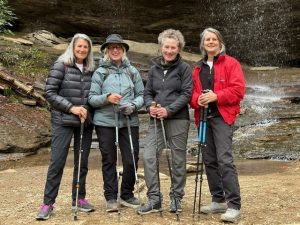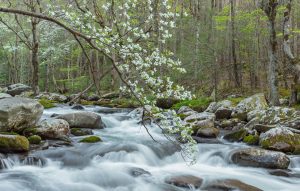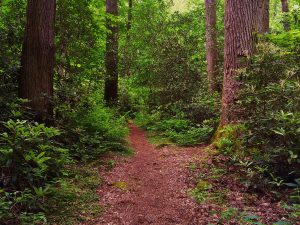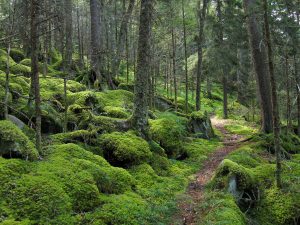
April 30 deadline to apply for Tremont Writers Conference
Frank X Walker and David Brill share a fascination with the Great Smoky Mountains. One

Frank X Walker and David Brill share a fascination with the Great Smoky Mountains. One


As the days grow warmer and the landscape ripples with color, a growing treetop chorus

Two decades ago, thousands of flies, bugs, and beetles met their end in insect traps

In the heart of Great Smoky Mountains National Park, the arrival of spring unveils a
Visits to Great Smoky Mountains National Park often are highlighted by sudden “moments” among the all-encompassing trees.

A black bear and her cubs pop out of undergrowth along a park roadway. The dense tree canopy on a ridge opens to reveal a view stretching far into the distance. A majestic old-growth tree spreads its branches out and up, a green giant against a blue sky. The best memories of the park are made of moments like these, but we don’t always pay attention to the spectacular trees themselves.
Great Smoky Mountains National Park is home to hundreds of some of the most impressive old-growth trees in the Appalachian range. White oaks, eastern white pines, black gums, tuliptrees, and eastern hemlocks, among others, dot the landscape throughout the park, largely because these forests have been protected for almost a century. Although 99 percent of the old-growth forest that could once be found in the eastern US is now gone thanks to logging, development, and agriculture, some 110,000 acres (equivalent to 175 square miles) of old-growth trees still remain in the park.
Where can a visitor get a close look at some of the park’s oldest and biggest trees? Steve Kemp, who has hiked throughout the park and knows its landscape as a long-time GSMA employee, offers a list of favorite trails:
For visitors looking for big trees along roadways:

Clingmans Dome Road is home to a high-elevation spruce-fir forest, while Parson Branch Road is dominated by pines and oaks. Many of the park’s trails, particularly those that climb significantly in elevation, offer a look at a variety of tree species.
Southern trees like sweetgum and umbrella magnolia can be found at the lowest elevations, while trees more typical of northern environments like the mountain maple and American mountain-ash make their home higher up the Smokies’ slopes. Along the way, the mountains also offer a wide range of habitats suitable for trees that thrive on both sunny, dry, south-facing slopes and cool, moist northern-facing slopes.
Before the park was established in 1934, mountain residents who lived in the area removed trees to clear land for agriculture, provide heat through long winters, and build log cabins, barns, and fences. The thick forests of the Smokies were also targets for lumber and paper companies, and thousands of trees that had grown to skyscraping heights and boasted big trunks fell to saws.
Between the 1880s and the 1930s, more than 20 lumber companies set up shop in the Smokies, and steam locomotives carried out trees with frightening efficiency. At the time, clearcutting was common, which resulted in catastrophic erosion and habitat loss. Conservative estimates put the total timber extracted from the Smokies during this period at approximately 2 billion board feet.
Advocates of the park hurried land acquisition to save as much of the old-growth forest as possible.

“It was kind of a race when the park was being created,” Kemp said. “The lumber companies were working as fast as they could to cut as many trees as possible. The conservationists were working as fast as they could to buy the land and negotiate with the lumber companies to stop the cutting of trees.”
Many of the park’s older trees were saved from the lumber companies’ axes and saws simply because they were located deep in mountain pockets or on steep mountainsides—areas difficult to reach. More recently, the biggest threats to the park’s trees are not the saw blades but pests and diseases.
While the balsam woolly adelgid devastated the park’s Fraser firs, the hemlock woolly adelgid spread throughout the Smokies beginning in 2002 and claimed stands upon stands of eastern hemlock, the “redwood of the East.” Every year, the National Park Service takes measures to mitigate tree loss from invasive pests and disease, using foliar treatments deployed from truck-mounted spray units, releasing predator beetles to feed on adelgids, and injecting insecticide directly into tree trunks.
The noble trees that remain are jewels in the Smokies landscape. Some are easily accessible along park trails and roads; hundreds of others are shielded in big swaths of forest, far from trails, and are infrequently seen by visitors. But they’re there, and they grow. Still.
You can read more about the Smokies’ remarkable old-growth forests in “The Last Best Wildwoods” by Steve Kemp in the fall 2022 issue of Smokies Life, vol. 16, no. 2.
The Great Smokies Welcome Center is located on U.S. 321 in Townsend, TN, 2 miles from the west entrance to Great Smoky Mountains National Park. Visitors can get information about things to see and do in and around the national park and shop from a wide selection of books, gifts, and other Smokies merchandise. Daily, weekly, and annual parking tags for the national park are also available.